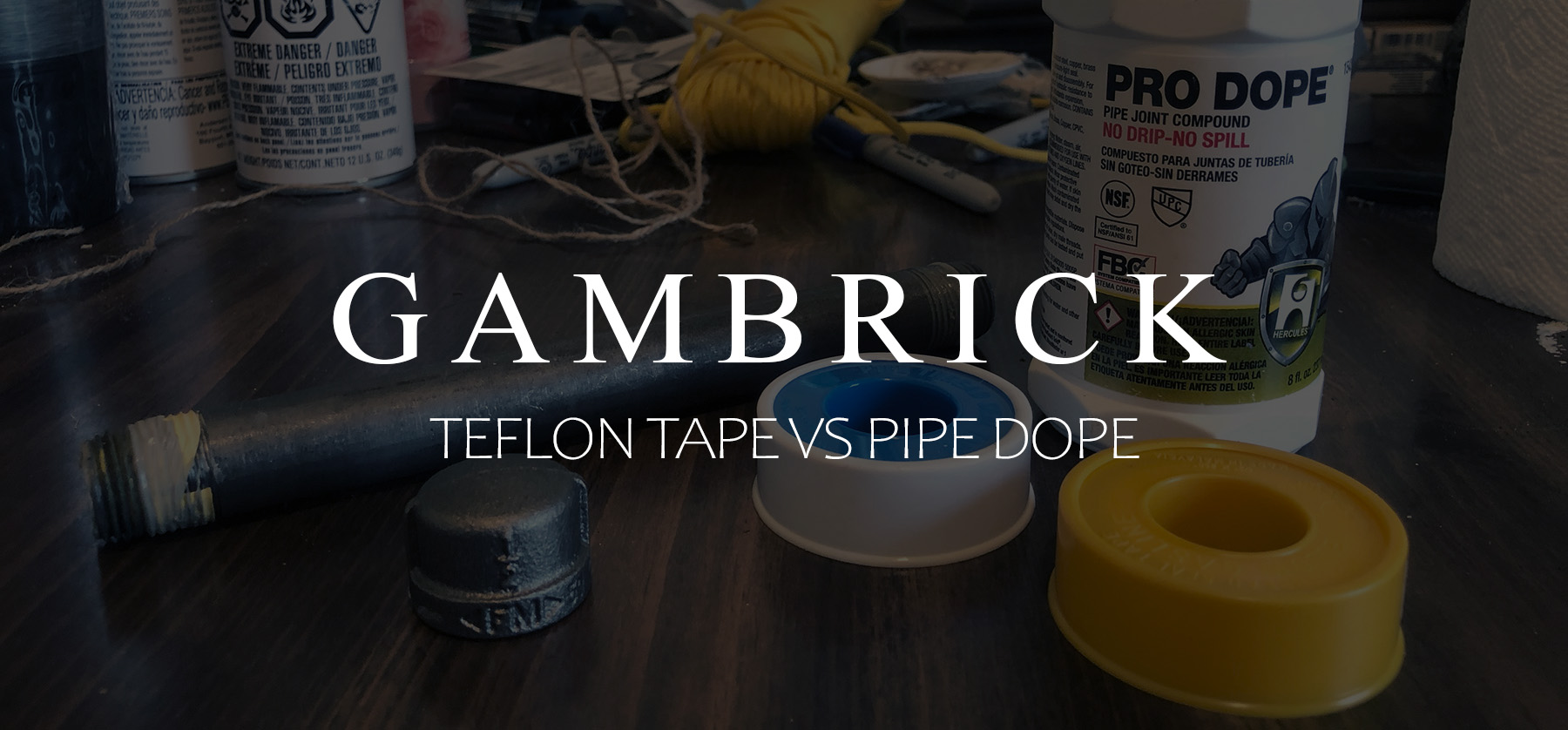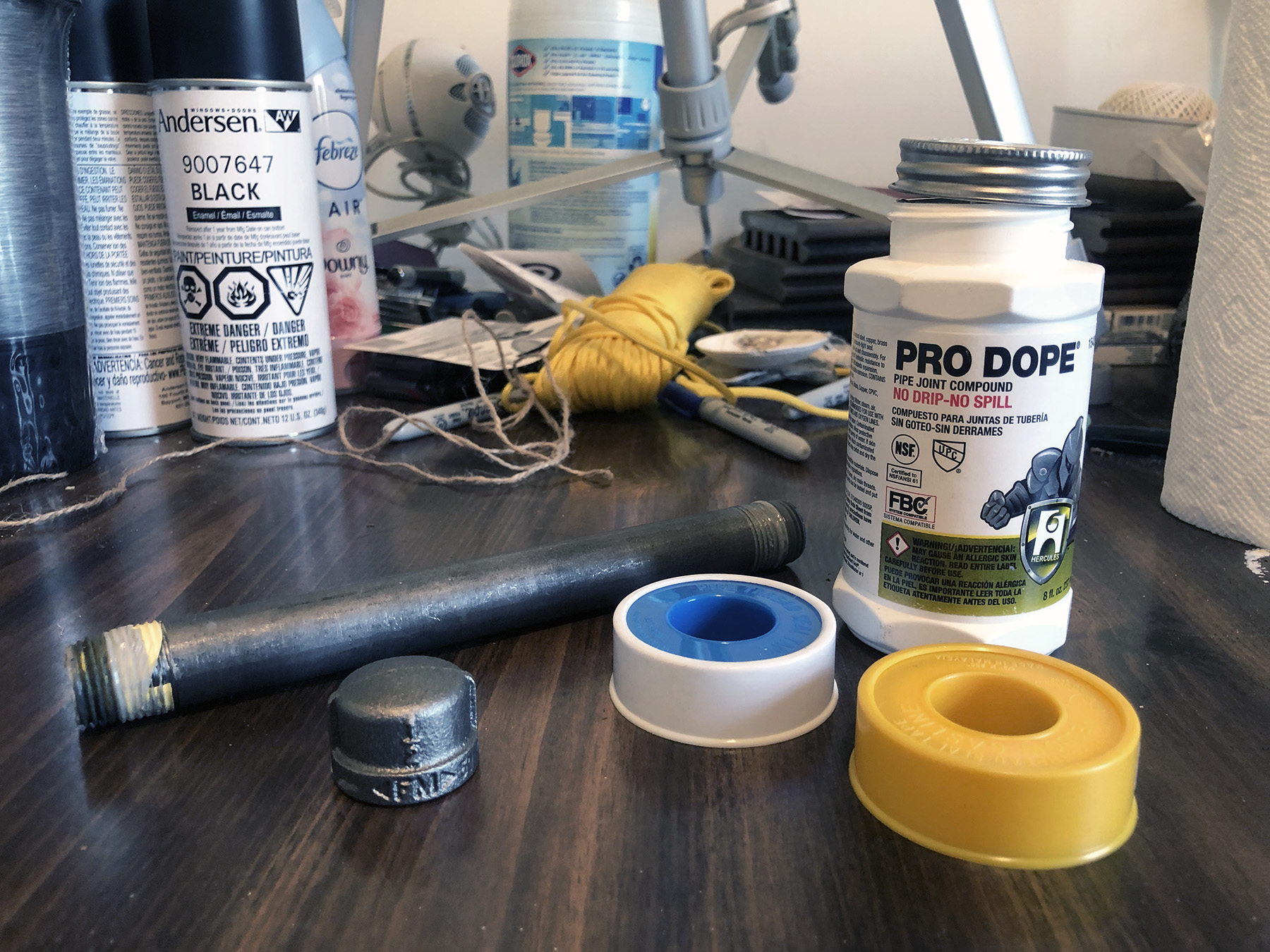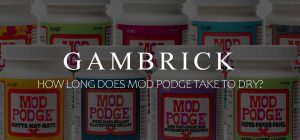Teflon Tape Vs Pipe Dope
Whenever a plumbing job requires connecting two threaded ends of a pipe, the threads must be sealed with either pipe dope or Teflon tape. It doesn’t matter if you’re using PVC, steel, brass or some other pipe material, all threads leak. If you don’t seal the threads prior to making a connection, whatever flows through the pipe will leak. There are two basic types of materials plumbers use to stop leaks: Teflon tape and Pipe Dope.
Both Teflon tape and Pipe Dope seal pipe threads in basically the same way. Even though pipe threads may appear tight when you screw them together, they’re not. There’s plenty of space between the threads which allows them to be screwed together. No matter how tight you screw the threads together, the space still exists and will leak fluid or gas. Unless of coarse you use a sealant. Sealants are placed onto the threads before you tighten. They essentially gum up the threads and rest in the small spaces which cause leaks.
Both Pipe Dope and Teflon tape are designed to gum up pipe threads which seals them and prevents leaks. However they do it in a slightly different way which makes Pipe Dope better that Teflon tape is some applications. And vice versa.
Using the wrong sealant can lead to leaks, water damage, and other major problems. It’s important to choose wisely when deciding on a pipe sealant. The decision should be based not only on the type of pipe you’re working with but also the substance running through the pipes.
In this article we’ll discuss Teflon tape vs Pipe Dope in detail along with which is better, when and why.
Teflon Tape
Pipe thread sealant tape, also called Teflon tape, PTFE tape, or Plumber’s tape, is a very popular type of pipe sealant. It comes in a roll like electrical tape and is color coded to dictate the type of substance it’s meant to be used with. White and pink Teflon tape is for water piping, green is for oxygen and yellow is for gas. Like Pipe Dope, it’s designed to seal threaded joints against leaks. The tape is flexible and stretchy which allows it to be tightly wrapped around pipe threads.
Teflon tape is a nonstick sealant tape that works as both a lubricant and a sealant. As the threaded parts of a piping system are connected, the tape lubricates the threads and creates a tight seal.
As you tighten two ends of a threaded pipe, the tape is squished between the threads which seals all the tiny gaps and crevices which could cause leaks.
Teflon tape comes in different thicknesses which makes it better or worse for particular jobs. You can also vary how many layers of tape you apply to the threads before tightening.
Teflon tape is very easy to apply. Simply wrap it around the threaded end of a fitting or pipe in the same direction as you twist to tighten. If you wrap the tape in the wrong direction it will either unravel or tear.
Because Teflon tape is fragile and easy to tear, many plumbers don’t use it to make permanent pipe connections. As the pipes and fitting are being connected and tightened there’s always a chance the tape could rip. If that happens, pieces of tape may find their way into a system, clogging filters, valves, or screens.
In addition, torn sealant tape could cause a bad seal and future leaks.
Advantages Of Teflon Tape Vs Pipe Dope
Teflon tape is the most popular type of pipe sealant. It’s easy to use, cheap and won’t make a mess. It provides lubrication which helps make tightening tight pipes easier which could prevent thread damage due to over-tightening. And it should be in stock at any hardware or plumbing supply store nationwide. I’ve even seen it sold at Walmart and my local grocery store.
Teflon tape is very easy to store when you’re done working. It comes in a resealable case which protects the remaining tape.
You get a lot of tape per roll. A single roll is usually more than enough to make all the threaded connection in every house we build.
- Easy to apply
- Clean application
- Very easy to find
- Easy to store
- Works on brass pipe
- Comes in a variety of colors which work on gas or water pipe
- The most popular DIY pipe sealant that’s also used by professionals
Disadvantages Of Teflon Tape
Teflon tape isn’t as good at sealing threaded connections as Pipe Dope for most pipes. It’s easy to tear which can cause leaks.
- Tears easily
- A tear can cause leaks
- Torn tape can end up in valves or filers
Another disadvantage is that Teflon tape comes in a variety of colors which dictate the substance it can be used on. White and pink are for water, yellow is for gas and green is for oxygen. This can be a plus since the color coding makes it easy to find the right tape for the job. But when compared to Pipe Dope it’s a negative since Pipe Dope can be used on any substance.
If you use Pipe Dope vs Teflon Tape on the same pipe with the same substance running through, Pipe Dope makes a better connection. It dries hard and seals tighter. Teflon tape is still a great product for sealing pipe, but with the exception of plastic pipes, Pipe Dope is almost always better.
Pipe Dope
Pipe Dope, also called pipe glue or PVC glue, is a putty-like adhesive pipe sealant that can be either white or clear. Typically, it’s applied to the threaded end of pipes and fittings with a small brush. The threaded end of a pipe fitting is called the male side. The great thing about Pipe Dope is that you can use it for different pipe materials carrying both liquid and gas.
To apply pipe dope, a small brush or spatula is generally used which comes with the container of pipe dope. However some plumbers spread it on by hand.
Pipe joint compound has been used by plumbers for decades. The compound brushes on easily as a putty-like adhesive but later dries hard when its liquid content starts to evaporate.
Apply a generous amount to the threads. When you make the connection, Pipe Dope will squish itself into all the tiny cracks and crevices between threads. It then hardens in place to prevent leaks.
Pipe dope creates a stronger seal than Teflon tape because it dries so hard. Many plumbers and other professionals use it instead of Teflon tape for threaded pipe seals that are permanent.
Pipe Dope helps lubricate threads as you twist which can help make some tight connections easier to tighten.
Advantages Of Pipe Dope Vs Teflon Tape
Pipe joint compound, a.k.a. Pipe Dope, is fairly easy to find, simple to use, and inexpensive. It works with all types of pipe and fitting materials, and it creates a very strong seal. But it can be messy and harder to store than Teflon Tape. Most professionals prefer it for permanent threaded pipe connections, however they still use Teflon tape from time to time.
Pipe dope typically creates a stronger seal than Teflon tape and it won’t tear when threading pipe fittings like tape can. It’s not as delicate a material as tape and can’t break off into small bits that end up in a filter or lodged in a valve somewhere.
Provides some lubrication to the threads which can help make some tight connections a little easier to tighten.
The same Pipe Dope can be used on different pipe materials carrying liquid or gas. This isn’t true of Teflon Tape which makes different color tape for gas, water or oxygen.
- Seals gas or water pipe
- Can be used on different pipe materials
- Easy to brush on
- Cheap
- Works on brass pipe
Disadvantages Of Pipe Dope
Pipe Dope is a fantastic way to seal threaded pipe fittings, but it still has a few disadvantages vs Teflon Tape.
Pipe Dope is not as good as Teflon Tape for sealing plastic or PVC pipe. Most pros I know use Pipe Dope for metal pipe and Teflon Tape for anything plastic.
Another disadvantage is that Pipe Dope is a little harder to find. They generally have it in stock as plumbing supply or Home Depot but I can get Teflon Tape at my local grocery store, Walmart or Target. If your a pro and at a hardware store it’s not a problem, but for the average DIY homeowner Teflon Tape is much easier to find.
Finally, Pipe Dope is a lot messier than using Teflon Tape. It’s a wet putty-like lubricant that comes in a tube or bucket and is applied by brush. If you’re not careful it can get on your hands when you thread the pipe and then on your clothes. Excess Pipe Dope that squeezes out when you tighten the fittings can be left on place or cleaned with a rag.
Teflon Tape isn’t like this, nothing rubs off on you when you touch tape and it’s much easier to clean when you’re done.
Why Do Plumbers Use Pipe Dope Vs Teflon Tape?
When a plumber or other professional needs to seal the threaded connection between2 pieces of pipe, they use either Pipe Dope or Teflon tape. Even though pipe threads may appear tight to the eye, there’s actually lots of space between them, which is how they thread together. This space is more than enough for water or gas to leak through no matter how tight you make the connection.
To prevent leaks, a sealant is applied to the threads before the connection is made. The sealant squishes into all the tiny cracks, gaps and crevices between pipe threads.
Pipe sealant has to be water-tight to prevent leaks and pressure-tight to prevent bursting.
The two most popular types of pipe sealant are solvent-based Pipe Dope or Teflon tape.
Pipe Dope is a sealant and a lubricant that typically comes in either a tube or bucket. It’s applied to the pipe threads with a small brush that comes included with the sealant.
Teflon tape is a non-sticky flexible tape that’s tightly wrap around pipe threads. The tape is always wrapped in the same direction as you twist which tightens the tape with the connection. If you apply the tape in the wrong direction it will unravel when you twist the pipes together.
Both Teflon Tape and Pipe Dope provide both a seal and some lubrication to the threads. This can help make some tight connections easier to tighten.
Should I Use Pipe Dope Or Teflon Tape?
Both Teflon Tape and Pipe Dope are fantastic products to seal a threaded pipe connection. And both are used by professionals on all of our new homes. Which one you should use on your project depends on the type of pipe you’re working with and what substance is flowing through them.
To seal water lines, drains and faucets, Teflon tape works best. As long as it’s installed properly by wrapping the threads in the direction they will turn while joining the seal will be very tight. It’s clean, easy to use and very dependable. My plumbers use it on all of our water lines and PVC threaded pipe fittings.
If your home has a gas dryer, stove, water heater or furnace, Pipe Dope works best. Natural gas is carried through steel pipes with threaded connections. Natural gas is highly flammable, explosive and dangerous, therefore, the threaded connections must not leak.
Building codes require the completed gas piping to be pressurized with air and gauged for at least twenty four hours to make sure there are no leaks. According to most building codes, either yellow Teflon tape or Pipe Dope can be used to seal a gas pipe. However, I prefer Pipe Dope.
Pipe Dope dried hard and strong which makes it a little better than Teflon tape for gas pipe. With tape, there’s always a chance for a tear you can’t see which could result in a leak.
Can You Use Teflon Tape & Pipe Dope Together?
Yes, Teflon tape and Pipe Dope can be used together on the same threaded pipe connection for an even tighter seal. Many plumbers do this for an extra level of protection against leaks. When you use Teflon tape and Pipe Dope together, always apply the tape first. Wrap the threads in 2-4 layers of tape in the same direction you twist to tighten. Then apply a small amount of Pipe Dope on top of the tape.
When you tighten the connection, the tape and Pipe Dope will squish into all the tine cracks, crevices and gaps between the threads.
Summary: Teflon Tape Vs Pipe Dope
Whenever a plumbing job requires connecting two threaded ends of a pipe, the threads must be sealed with either pipe dope or Teflon tape. It doesn’t matter if you’re using PVC, steel, brass or some other pipe material, all threads leak. If you don’t seal the threads prior to making a connection, whatever flows through the pipe will leak. There are two basic types of materials plumbers use to stop leaks: Teflon tape and Pipe Dope.
Both Teflon tape and Pipe Dope seal pipe threads in basically the same way. Even though pipe threads may appear tight when you screw them together, they’re not. There’s plenty of space between the threads which allows them to be screwed together. No matter how tight you screw the threads together, the space still exists and will leak fluid or gas. Unless of coarse you use a sealant. Sealants are placed onto the threads before you tighten. They essentially gum up the threads and rest in the small spaces which cause leaks.
Both Pipe Dope and Teflon tape are designed to gum up pipe threads which seals them and prevents leaks. However they do it in a slightly different way which makes Pipe Dope better that Teflon tape is some applications. And vice versa.
Using the wrong sealant can lead to leaks, water damage, and other major problems. It’s important to choose wisely when deciding on a pipe sealant. The decision should be based not only on the type of pipe you’re working with but also the substance running through the pipes.
In this article we’ll discuss Teflon tape vs Pipe Dope in detail along with which is better, when and why.
If you have any questions or comments e-mail us any time.






















